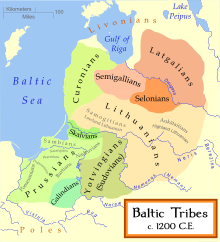| Galindan | |
|---|---|
| Galindian | |
| Region | North-eastern Poland |
| Extinct | Fourteenth century |
| Language codes | |
| ISO 639-3 | xgl |
xgl | |
| Glottolog | None |

The term Galindian is sometimes ascribed to two separate Baltic languages, both of which where peripheral dialects:
- First, a Western Baltic language referred to as West Galindian; and
- Second, a Baltic language previously spoken in Mozhaysk region (present day Russia), referred to as East Galindian[1]
Name
There are three poposed etymologies for the denomination Galindian:[2]: 308–309
- Proto-Baltic *Galind- meaning 'outsider' (Lithuanian: gãlas 'wall; border').[3] This is supported by the etymology of the common Old Russian term for the Galindians Russian: Голядь Goljad' > *golędь > Baltic *Galind-);
- It is derived from the root *gal-/*gil found in Baltic Hydronyms;[4][5] and
- The name means "the powerful ones" (Lithuanian: galià 'power, strengh') and also Celtic languages (Irish: gal 'strengh', Welsh: gallus 'power', Galli, Gallia).[6]
Proposed relation
Based on the common name used for the two people by ancient authors, some scientists propose a common origine of the two people and languages.[2]: 309 [7] In order to prove this hypothesis, they investigate common features between Old Prussian/West Galindian and East Galindian.[2]: 309–310
West Galindian
West Galindian is the poorly attested extinct Baltic language of the Galindians previously spoken in what is today North-eastern Poland and thought to have been a dialect of Old Prussian,[2]: 290 or a Western Baltic language similar to Old Prussian.[8] There are no extant writings in Galindian.
East Galindian

East Galindian is the poorly attested extinct Baltic language of the Balts living in the Protva Basin in present-day Russia.[2]: 307
Phonology
Based on Baltic substratum and hydronomy in the Protva Basin, the following phonology can be reconstructed:[2]: 311–312
Consonants
| Labial | Dental/ Alveolar |
Post- alveolar |
Velar | |||
|---|---|---|---|---|---|---|
| plain | pal. | |||||
| Nasal | m | n | nʲ | |||
| Plosive | voiceless | p | t | tʲ | tʃ | k |
| voiced | b | d | dʲ | ɡ | ||
| Fricative | voiceless | s | ʃ | |||
| voiced | v | z | ʒ | |||
| Trill | r | rʲ | ||||
| Approximant | l | lʲ | j | |||
Vowels
| Front | Central | Back | |
|---|---|---|---|
| High | i iː | u uː | |
| Mid | eː | oː | |
| Mid-low | ɛ | ||
| Low | a aː |
References
- ^ "galindai" [The Galindians]. Visuotinę lietuvių enciklopediją (in Lithuanian). Mokslo ir enciklopedijų leidybos centras. Retrieved 2022-01-28.
- ^ a b c d e f Dini, Pietro U. (2014). Foundations of Baltic languages. Translated by Richardson, Milda B.; Richardson, Robert E. Vilnius: Vilniaus universitetas. ISBN 978-609-437-263-6.
- ^ Būga, Kazimieras (1924). Lietuvių tauta ir kalba bei jos artimieji giminaičiai [The language and nation of the Lithuanians and its close relatives] (in Lithuanian). Kaunas.
{{cite book}}: CS1 maint: location missing publisher (link) - ^ Nalepa, Jerzy (1971). "Próba nowej etymologii nazwy Galindia czyli Golędź" [Proposal of a new etymology of the name Galindia or Golędź]. Opuscula slavica 1. Slaviska och baltiska studier (in Polish). Vol. 9. Lund: Slaviska institutionen vid Lunds universitet. pp. 93–115.
- ^ Mažiulis, Vytautas (1981). Prūsų kalbos paminklai [Monuments of the Prussian language] (in Lithuanian). Vol. II. Vilnius: Mokslas. pp. 318–319.
- ^ Schmid, Wolfgang P. (1998). "Galinder" [Galindians]. In Beck, Heinrich; Geuenich, Dieter; Steuer, Heiko (eds.). Reallexikon der germanischen Alterskunde [Dictionary of Germanic antiquities] (in German). Vol. 10 (2nd revised and enlarged ed.). Berlin, Boston: De Gruyter. pp. 325–327. ISBN 978-3-11-015102-2.
- ^ Otrębski, Jan Szczepan (1958). "Zagadnienie Galindów" [The Problem of Galindians]. In Gieysztor, Aleksander (ed.). Studia Historica. W 35-lecia pracy naukowej Henryka Łowmiańskiego [Studia Historica. On the 35th jubilee of Henryk Łowmiański's scientific work] (in Polish). Warsaw: Państwowe Wydawn. Naukowe. pp. 37–41.
- ^ Tarasov, Iliya (January 2017). "The Balts in the migration period". Istoričeskij Format Исторический Формат (in Russian). 3–4: 95–124.